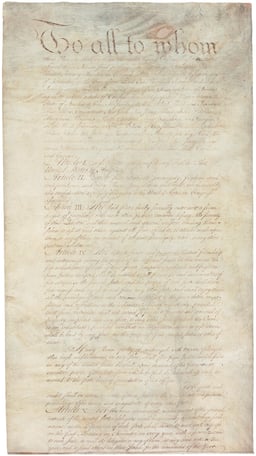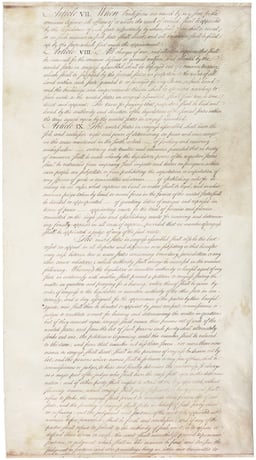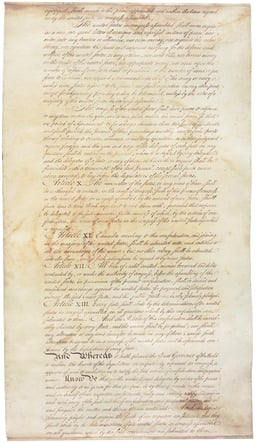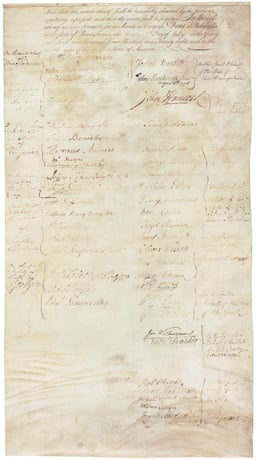Articles of Confederation
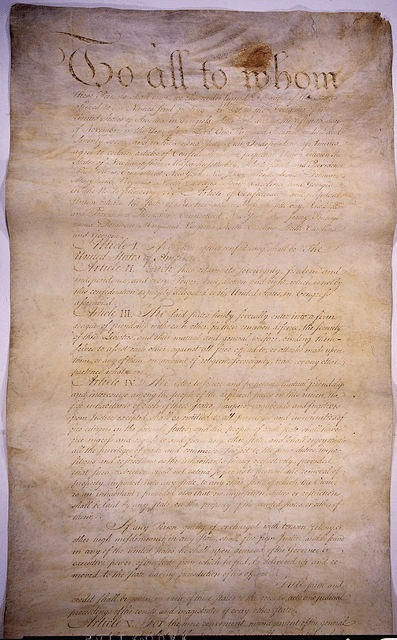
Articles of Confederation

| Articles of Confederation | |
|---|---|
| Created | November 15, 1777 |
| Ratified | March 1, 1781 |
| Location | National Archives |
| Author(s) | Continental Congress |
| Signatories | Continental Congress |
| Purpose | First constitution for the United States; replaced by the current United States Constitution on March 4, 1789 |
The Articles of Confederation and Perpetual Union was an agreement among the 13 original states of the United States of America that served as its first constitution.[1] It was approved, after much debate (between July 1776 and November 1777), by the Second Continental Congress on November 15, 1777, and sent to the states for ratification. The Articles of Confederation came into force on March 1, 1781, after being ratified by all 13 states. A guiding principle of the Articles was to preserve the independence and sovereignty of the states. The weak central government established by the Articles received only those powers which the former colonies had recognized as belonging to king and parliament.[2]
The document provided clearly written rules for how the states' "league of friendship" would be organized. During the ratification process, the Congress looked to the Articles for guidance as it conducted business, directing the war effort, conducting diplomacy with foreign nations, addressing territorial issues and dealing with Native American relations. Little changed politically once the Articles of Confederation went into effect, as ratification did little more than legalize what the Continental Congress had been doing. That body was renamed the Congress of the Confederation; but most Americans continued to call it the Continental Congress, since its organization remained the same.[2]
As the Confederation Congress attempted to govern the continually growing American states, delegates discovered that the limitations placed upon the central government rendered it ineffective at doing so. As the government's weaknesses became apparent, especially after Shays' Rebellion, some prominent political thinkers in the fledgling nation began asking for changes to the Articles. Their hope was to create a stronger national government. Initially, some states met to deal with their trade and economic problems. However, as more states became interested in meeting to change the Articles, a meeting was set in Philadelphia on May 25, 1787. This became the Constitutional Convention. It was quickly agreed that changes would not work, and instead the entire Articles needed to be replaced.[3] On March 4, 1789, the government under the Articles was replaced with the federal government under the Constitution.[4] The new Constitution provided for a much stronger federal government by establishing a chief executive (the President), courts, and taxing powers.
| Articles of Confederation | |
|---|---|
| Created | November 15, 1777 |
| Ratified | March 1, 1781 |
| Location | National Archives |
| Author(s) | Continental Congress |
| Signatories | Continental Congress |
| Purpose | First constitution for the United States; replaced by the current United States Constitution on March 4, 1789 |
Background and context
The political push to increase cooperation among the then-loyal colonies began with the Albany Congress in 1754 and Benjamin Franklin's proposed Albany Plan, an inter-colonial collaboration to help solve mutual local problems. Over the next two decades, some of the basic concepts it addressed would strengthen; others would weaken, especially in the degree of loyalty (or lack thereof) owed the Crown. Civil disobedience resulted in coercive and quelling measures, such as the passage of what the colonials referred to as the intolerable acts in the English Parliament, and armed skirmishes which resulted in dissidents being proclaimed rebels. These actions eroded the number of Crown Loyalists (aka Tories) among the colonials and, together with the highly effective propaganda campaign of the Patriot leaders, caused an increasing number of colonists to begin agitating for independence from the mother country. In 1775, with events outpacing communications, the Second Continental Congress began acting as the provisional government.
It was an era of constitution writing—most states were busy at the task—and leaders felt the new nation must have a written constitution; a "rulebook" for how the new nation should function. During the war, Congress exercised an unprecedented level of political, diplomatic, military and economic authority. It adopted trade restrictions, established and maintained an army, issued fiat money, created a military code and negotiated with foreign governments.[5]
To transform themselves from outlaws into a legitimate nation, the colonists needed international recognition for their cause and foreign allies to support it. In early 1776, Thomas Paine argued in the closing pages of the first edition of Common Sense that the "custom of nations" demanded a formal declaration of American independence if any European power were to mediate a peace between the Americans and Great Britain. The monarchies of France and Spain in particular could not be expected to aid those they considered rebels against another legitimate monarch. Foreign courts needed to have American grievances laid before them persuasively in a "manifesto" which could also reassure them that the Americans would be reliable trading partners. Without such a declaration, Paine concluded, "[t]he custom of all courts is against us, and will be so, until, by an independence, we take rank with other nations."[6]
Beyond improving their existing association, the records of the Second Continental Congress show that the need for a declaration of independence was intimately linked with the demands of international relations. On June 7, 1776, Richard Henry Lee introduced a resolution before the Continental Congress declaring the colonies independent; at the same time he also urged Congress to resolve "to take the most effectual measures for forming foreign Alliances" and to prepare a plan of confederation for the newly independent states. Congress then created three overlapping committees to draft the Declaration, a Model Treaty, and the Articles of Confederation. The Declaration announced the states' entry into the international system; the model treaty was designed to establish amity and commerce with other states; and the Articles of Confederation, which established "a firm league" among the thirteen free and independent states, constituted an international agreement to set up central institutions for the conduct of vital domestic and foreign affairs.[7]
Drafting
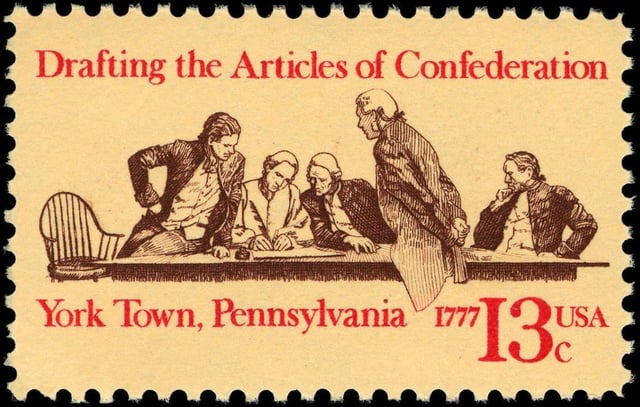
1977 13-cent U.S. Postage stamp commemorating the Articles of Confederation bicentennial; the draft was completed on November 15, 1777
On June 12, 1776, a day after appointing a committee to prepare a draft of the Declaration of Independence, the Second Continental Congress resolved to appoint a committee of 13 to prepare a draft of a constitution for a union of the states. The committee met frequently, and chairman John Dickinson presented their results to the Congress on July 12, 1776. Afterward, there were long debates on such issues as state sovereignty, the exact powers to be given to Congress, whether to have a judiciary, western land claims and voting procedures.[8] To further complicate work on the constitution, Congress was forced to leave Philadelphia twice, for Baltimore, Maryland in the winter of 1776, and later for Lancaster then York, Pennsylvania in the fall of 1777, to evade advancing British troops. Even so, the committee continued with its work.
The final draft of the Articles of Confederation and Perpetual Union was completed on November 15, 1777.[9] Consensus was achieved by: including language guaranteeing that each state retained its sovereignty, leaving the matter of western land claims in the hands of the individual states, including language stating that votes in Congress would be en bloc by state, and establishing a unicameral legislature with limited and clearly delineated powers.[10]
Ratification
The Articles of Confederation was submitted to the states for ratification in late November 1777. The first state to ratify was Virginia on December 16, 1777; 12 states had ratified the Articles by February 1779, 14 months into the process.[11] The lone holdout, Maryland, refused to go along until the landed states, especially Virginia, had indicated they were prepared to cede their claims west of the Ohio River to the Union.[12] It would be two years before the Maryland General Assembly became satisfied that the various states would follow through, and voted to ratify. During this time, Congress observed the Articles as its de facto frame of government. Maryland finally ratified the Articles on February 2, 1781. Congress was informed of Maryland's assent on March 1, and officially proclaimed the Articles of Confederation to be the law of the land.[11][13][14]
The several states ratified the Articles of Confederation on the following dates:[15]
| State | Date | |
|---|---|---|
| 1 | December 16, 1777 | |
| 2 | February 5, 1778 | |
| 3 | February 6, 1778 | |
| 4 | February 9, 1778 | |
| 5 | February 12, 1778 | |
| 6 | February 26, 1778 | |
| 7 | March 4, 1778 | |
| 8 | March 5, 1778 | |
| 9 | March 10, 1778 | |
| 10 | April 5, 1778 | |
| 11 | November 19, 1778 | |
| 12 | February 1, 1779 | |
| 13 | February 2, 1781 | |
Article summaries
The Articles of Confederation contain a preamble, thirteen articles, a conclusion, and a signatory section. The individual articles set the rules for current and future operations of the confederation's central government. Under the Articles, the states retained sovereignty over all governmental functions not specifically relinquished to the national Congress, which was empowered to make war and peace, negotiate diplomatic and commercial agreements with foreign countries, and to resolve disputes between the states. The document also stipulates that its provisions "shall be inviolably observed by every state" and that "the Union shall be perpetual".
Summary of the purpose and content of each of the 13 articles:
Establishes the name of the confederation with these words: "The stile of this confederacy shall be 'The United States of America.'"
Asserts the sovereignty of each state, except for the specific powers delegated to the confederation government: "Each state retains its sovereignty, freedom, and independence, and every power, jurisdiction, and right, which is not by this Confederation expressly delegated."
Declares the purpose of the confederation: "The said States hereby severally enter into a firm league of friendship with each other, for their common defense, the security of their liberties, and their mutual and general welfare, binding themselves to assist each other, against all force offered to, or attacks made upon them, or any of them, on account of religion, sovereignty, trade, or any other pretense whatever."
Elaborates upon the intent "to secure and perpetuate mutual friendship and intercourse among the people of the different States in this union," and to establish equal treatment and freedom of movement for the free inhabitants of each state to pass unhindered between the states, excluding "paupers, vagabonds, and fugitives from justice." All these people are entitled to equal rights established by the state into which they travel. If a crime is committed in one state and the perpetrator flees to another state, he will be extradited to and tried in the state in which the crime was committed.
Allocates one vote in the Congress of the Confederation (the "United States in Congress Assembled") to each state, which is entitled to a delegation of between two and seven members. Members of Congress are to be appointed by state legislatures. No congressman may serve more than three out of any six years.
Only the central government may declare war, or conduct foreign political or commercial relations. No state or official may accept foreign gifts or titles, and granting any title of nobility is forbidden to all. No states may form any sub-national groups. No state may tax or interfere with treaty stipulations already proposed. No state may wage war without permission of Congress, unless invaded or under imminent attack on the frontier; no state may maintain a peacetime standing army or navy, unless infested by pirates, but every State is required to keep ready, a well-trained, disciplined, and equipped militia.
Whenever an army is raised for common defense, the state legislatures shall assign military ranks of colonel and below.
Expenditures by the United States of America will be paid with funds raised by state legislatures, and apportioned to the states in proportion to the real property values of each.
Powers and functions of the United States in Congress Assembled. Grants to the United States in Congress assembled the sole and exclusive right and power to determine peace and war; to exchange ambassadors; to enter into treaties and alliances, with some provisos; to establish rules for deciding all cases of captures or prizes on land or water; to grant letters of marque and reprisal (documents authorizing privateers) in times of peace; to appoint courts for the trial of pirates and crimes committed on the high seas; to establish courts for appeals in all cases of captures, but no member of Congress may be appointed a judge; to set weights and measures (including coins), and for Congress to serve as a final court for disputes between states. The court will be composed of jointly appointed commissioners or Congress shall appoint them. Each commissioner is bound by oath to be impartial. The court's decision is final. Congress shall regulate the post offices; appoint officers in the military; and regulate the armed forces. The United States in Congress assembled may appoint a president who shall not serve longer than one year per three-year term of the Congress. Congress may request requisitions (demands for payments or supplies) from the states in proportion with their population, or take credit. Congress may not declare war, enter into treaties and alliances, appropriate money, or appoint a commander in chief without nine states assented. Congress shall keep a journal of proceedings and adjourn for periods not to exceed six months.
When Congress is in recess, any of the powers of Congress may be executed by "The committee of the states, or any nine of them", except for those powers of Congress which require nine states in Congress to execute.
If Canada (referring to the British Province of Quebec) accedes to this confederation, it will be admitted.[16] No other colony could be admitted without the consent of nine states.
Reaffirms that the Confederation accepts war debt incurred by Congress before the existence of the Articles.
Declares that the Articles shall be perpetual, and may be altered only with the approval of Congress and the ratification of all the state legislatures.
Congress under the Articles
The army
Under the Articles, Congress had the authority to regulate and fund the Continental Army, but it lacked the power to compel the States to comply with requests for either troops or funding. This left the military vulnerable to inadequate funding, supplies, and even food.[17] Further, although the Articles enabled the states to present a unified front when dealing with the European powers, as a tool to build a centralized war-making government, they were largely a failure; Historian Bruce Chadwick wrote:
George Washington had been one of the very first proponents of a strong federal government. The army had nearly disbanded on several occasions during the winters of the war because of the weaknesses of the Continental Congress. ... The delegates could not draft soldiers and had to send requests for regular troops and militia to the states. Congress had the right to order the production and purchase of provisions for the soldiers, but could not force anyone to supply them, and the army nearly starved in several winters of war.[18]
The Continental Congress, before the Articles were approved, had promised soldiers a pension of half pay for life. However Congress had no power to compel the states to fund this obligation, and as the war wound down after the victory at Yorktown the sense of urgency to support the military was no longer a factor. No progress was made in Congress during the winter of 1783–84. General Henry Knox, who would later become the first Secretary of War under the Constitution, blamed the weaknesses of the Articles for the inability of the government to fund the army. The army had long been supportive of a strong union.[19] Knox wrote:
The army generally have always reprobated the idea of being thirteen armies. Their ardent desires have been to be one continental body looking up to one sovereign. ... It is a favorite toast in the army, "A hoop to the barrel" or "Cement to the Union".[20]
As Congress failed to act on the petitions, Knox wrote to Gouverneur Morris, four years before the Philadelphia Convention was convened, "As the present Constitution is so defective, why do not you great men call the people together and tell them so; that is, to have a convention of the States to form a better Constitution."[20]
Once the war had been won, the Continental Army was largely disbanded. A very small national force was maintained to man the frontier forts and to protect against Native American attacks. Meanwhile, each of the states had an army (or militia), and 11 of them had navies. The wartime promises of bounties and land grants to be paid for service were not being met. In 1783, George Washington defused the Newburgh conspiracy, but riots by unpaid Pennsylvania veterans forced Congress to leave Philadelphia temporarily.[21]
The Congress from time to time during the Revolutionary War requisitioned troops from the states. Any contributions were voluntary, and in the debates of 1788 the Federalists (who supported the proposed new Constitution) claimed that state politicians acted unilaterally, and contributed when the Continental army protected their state's interests. The Anti-Federalists claimed that state politicians understood their duty to the Union and contributed to advance its needs. Dougherty (2009) concludes that generally the States' behavior validated the Federalist analysis. This helps explain why the Articles of Confederation needed reforms.[22]
Foreign policy
The 1783 Treaty of Paris, which ended hostilities with Great Britain, languished in Congress for several months because too few delegates were present at any one time to constitute a quorum so that it could be ratified. Afterward, the problem only got worse as Congress had no power to enforce attendance. Rarely did more than half of the roughly sixty delegates attend a session of Congress at the time, causing difficulties in raising a quorum. The resulting paralysis embarrassed and frustrated many American nationalists, including George Washington. Many of the most prominent national leaders, such as Washington, John Adams, John Hancock, and Benjamin Franklin, retired from public life, served as foreign delegates, or held office in state governments; and for the general public, local government and self-rule seemed quite satisfactory. This served to exacerbate Congress's impotence.[23]
Inherent weaknesses in the confederation's frame of government also frustrated the ability of the government to conduct foreign policy. In 1786, Thomas Jefferson, concerned over the failure of Congress to fund an American naval force to confront the Barbary pirates, wrote in a diplomatic correspondence to James Monroe that, "It will be said there is no money in the treasury. There never will be money in the treasury till the Confederacy shows its teeth."[24]
Furthermore, the 1786 Jay–Gardoqui Treaty with Spain also showed weakness in foreign policy. In this treaty, which was never ratified, the United States was to give up rights to use the Mississippi River for 25 years, which would have economically strangled the settlers west of the Appalachian Mountains. Finally, due to the Confederation's military weakness, it could not compel the British army to leave frontier forts which were on American soil — forts which, in 1783, the British promised to leave, but which they delayed leaving pending U.S. implementation of other provisions such as ending action against Loyalists and allowing them to seek compensation. This incomplete British implementation of the Treaty of Paris would later be resolved by the implementation of Jay's Treaty in 1795, after the federal Constitution came into force.
Taxation and commerce
Under the Articles of Confederation, the central government's power was kept quite limited. The Confederation Congress could make decisions, but lacked enforcement powers. Implementation of most decisions, including modifications to the Articles, required unanimous approval of all thirteen state legislatures.[25]
Congress was denied any powers of taxation: it could only request money from the states. The states often failed to meet these requests in full, leaving both Congress and the Continental Army chronically short of money. As more money was printed by Congress, the continental dollars depreciated. In 1779, George Washington wrote to John Jay, who was serving as the president of the Continental Congress, "that a wagon load of money will scarcely purchase a wagon load of provisions."[26] Mr. Jay and the Congress responded in May by requesting $45 million from the States. In an appeal to the States to comply, Jay wrote that the taxes were "the price of liberty, the peace, and the safety of yourselves and posterity."[27] He argued that Americans should avoid having it said "that America had no sooner become independent than she became insolvent" or that "her infant glories and growing fame were obscured and tarnished by broken contracts and violated faith."[28] The States did not respond with any of the money requested from them.
Congress had also been denied the power to regulate either foreign trade or interstate commerce and, as a result, all of the States maintained control over their own trade policies. The states and the Confederation Congress both incurred large debts during the Revolutionary War, and how to repay those debts became a major issue of debate following the War. Some States paid off their war debts and others did not. Federal assumption of the states' war debts became a major issue in the deliberations of the Constitutional Convention.
Accomplishments
Nevertheless, the Confederation Congress did take two actions with long-lasting impact. The Land Ordinance of 1785 and Northwest Ordinance created territorial government, set up protocols for the admission of new states and the division of land into useful units, and set aside land in each township for public use. This system represented a sharp break from imperial colonization, as in Europe, and it established the precedent by which the national (later, federal) government would be sovereign and expand westward—as opposed to the existing states doing so under their sovereignty.[29]
The Land Ordinance of 1785 established both the general practices of land surveying in the west and northwest and the land ownership provisions used throughout the later westward expansion beyond the Mississippi River. Frontier lands were surveyed into the now-familiar squares of land called the township (36 square miles), the section (one square mile), and the quarter section (160 acres). This system was carried forward to most of the States west of the Mississippi (excluding areas of Texas and California that had already been surveyed and divided up by the Spanish Empire). Then, when the Homestead Act was enacted in 1867, the quarter section became the basic unit of land that was granted to new settler-farmers.
The Northwest Ordinance of 1787 noted the agreement of the original states to give up northwestern land claims, organized the Northwest Territory and laid the groundwork for the eventual creation of new states. While it didn't happen under the articles, the land north of the Ohio River and west of the (present) western border of Pennsylvania ceded by Massachusetts, Connecticut, New York, Pennsylvania, and Virginia, eventually became the states of: Ohio, Indiana, Illinois, Michigan, and Wisconsin, and the part of Minnesota east of the Mississippi River. The Northwest Ordinance of 1787 also made great advances in the abolition of slavery. New states admitted to the union in this territory would never be slave states.
No new states were admitted to the Union under the Articles of Confederation. The Articles provided for a blanket acceptance of the Province of Quebec (referred to as "Canada" in the Articles) into the United States if it chose to do so. It did not, and the subsequent Constitution carried no such special provision of admission. Additionally, ordinances to admit Frankland (later modified to Franklin), Kentucky, and Vermont to the Union were considered, but none were approved.
Presidents of Congress
Under the Articles of Confederation, the presiding officer of Congress—referred to in many official records as President of the United States in Congress Assembled—chaired the Committee of the States when Congress was in recess, and performed other administrative functions. He was not, however, an executive in the way the later President of the United States is a chief executive, since all of the functions he executed were under the direct control of Congress.[30]
There were 10 presidents of Congress under the Articles. The first, Samuel Huntington, had been serving as president of the Continental Congress since September 28, 1779.
| President | Term |
|---|---|
| Samuel Huntington | March 1, 1781 – July 10, 1781 |
| Thomas McKean | July 10, 1781 – November 5, 1781 |
| John Hanson | November 5, 1781 – November 4, 1782 |
| Elias Boudinot | November 4, 1782 – November 3, 1783 |
| Thomas Mifflin | November 3, 1783 – June 3, 1784 |
| Richard Henry Lee | November 30, 1784 – November 4, 1785 |
| John Hancock | November 23, 1785 – June 5, 1786 |
| Nathaniel Gorham | June 6, 1786 – November 3, 1786 |
| Arthur St. Clair | February 2, 1787 – November 4, 1787 |
| Cyrus Griffin | January 22, 1788 – November 15, 1788 |
The U.S. under the Articles
The peace treaty left the United States independent and at peace but with an unsettled governmental structure. The Articles envisioned a permanent confederation, but granted to the Congress—the only federal institution—little power to finance itself or to ensure that its resolutions were enforced. There was no president, no executive agencies, no judiciary and no tax base. The absence of a tax base meant that there was no way to pay off state and national debts from the war years except by requesting money from the states, which seldom arrived.[31][32] Although historians generally agree that the Articles were too weak to hold the fast-growing nation together, they do give credit to the settlement of the western issue, as the states voluntarily turned over their lands to national control.[33]
By 1783, with the end of the British blockade, the new nation was regaining its prosperity. However, trade opportunities were restricted by the mercantilism of the British and French empires. The ports of the British West Indies were closed to all staple products which were not carried in British ships. France and Spain established similar policies. Simultaneously, new manufacturers faced sharp competition from British products which were suddenly available again. Political unrest in several states and efforts by debtors to use popular government to erase their debts increased the anxiety of the political and economic elites which had led the Revolution. The apparent inability of the Congress to redeem the public obligations (debts) incurred during the war, or to become a forum for productive cooperation among the states to encourage commerce and economic development, only aggravated a gloomy situation. In 1786–87, Shays' Rebellion, an uprising of dissidents in western Massachusetts against the state court system, threatened the stability of state government.[34]
The Continental Congress printed paper money which was so depreciated that it ceased to pass as currency, spawning the expression "not worth a continental". Congress could not levy taxes and could only make requisitions upon the States. Less than a million and a half dollars came into the treasury between 1781 and 1784, although the governors had been asked for two million in 1783 alone.[35]
When John Adams went to London in 1785 as the first representative of the United States, he found it impossible to secure a treaty for unrestricted commerce. Demands were made for favors and there was no assurance that individual states would agree to a treaty. Adams stated it was necessary for the States to confer the power of passing navigation laws to Congress, or that the States themselves pass retaliatory acts against Great Britain. Congress had already requested and failed to get power over navigation laws. Meanwhile, each State acted individually against Great Britain to little effect. When other New England states closed their ports to British shipping, Connecticut hastened to profit by opening its ports.[36]
By 1787 Congress was unable to protect manufacturing and shipping. State legislatures were unable or unwilling to resist attacks upon private contracts and public credit. Land speculators expected no rise in values when the government could not defend its borders nor protect its frontier population.[37]
The idea of a convention to revise the Articles of Confederation grew in favor. Alexander Hamilton realized while serving as Washington's top aide that a strong central government was necessary to avoid foreign intervention and allay the frustrations due to an ineffectual Congress. Hamilton led a group of like-minded nationalists, won Washington's endorsement, and convened the Annapolis Convention in 1786 to petition Congress to call a constitutional convention to meet in Philadelphia to remedy the long-term crisis.[38]
Signatures
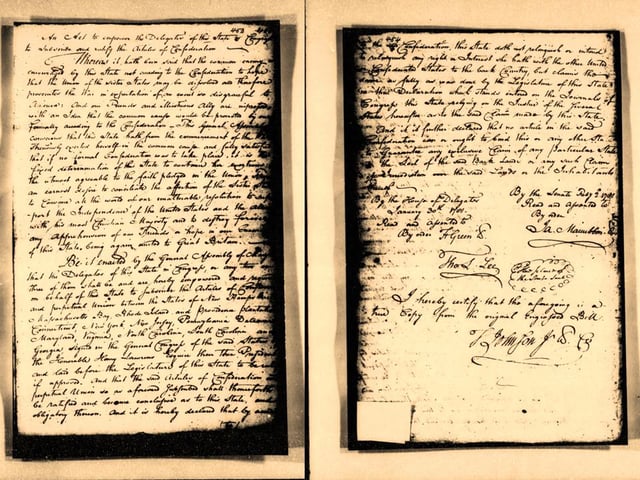
The Act of the Maryland legislature to ratify the Articles of Confederation, February 2, 1781
The Second Continental Congress approved the Articles for distribution to the states on November 15, 1777. A copy was made for each state and one was kept by the Congress. On November 28, the copies sent to the states for ratification were unsigned, and the cover letter, dated November 17, had only the signatures of Henry Laurens and Charles Thomson, who were the President and Secretary to the Congress.
The Articles, however, were unsigned, and the date was blank. Congress began the signing process by examining their copy of the Articles on June 27, 1778. They ordered a final copy prepared (the one in the National Archives), and that delegates should inform the secretary of their authority for ratification.
On July 9, 1778, the prepared copy was ready. They dated it, and began to sign. They also requested each of the remaining states to notify its delegation when ratification was completed. On that date, delegates present from New Hampshire, Massachusetts, Rhode Island, Connecticut, New York, Pennsylvania, Virginia and South Carolina signed the Articles to indicate that their states had ratified. New Jersey, Delaware and Maryland could not, since their states had not ratified. North Carolina and Georgia also were unable to sign that day, since their delegations were absent.
After the first signing, some delegates signed at the next meeting they attended. For example, John Wentworth of New Hampshire added his name on August 8. John Penn was the first of North Carolina's delegates to arrive (on July 10), and the delegation signed the Articles on July 21, 1778.
The other states had to wait until they ratified the Articles and notified their Congressional delegation. Georgia signed on July 24, New Jersey on November 26, and Delaware on February 12, 1779. Maryland refused to ratify the Articles until every state had ceded its western land claims. Chevalier de La Luzerne, French Minister to the United States, felt that the Articles would help strengthen the American government. In 1780 when Maryland requested France provide naval forces in the Chesapeake Bay for protection from the British (who were conducting raids in the lower part of the bay), he indicated that French Admiral Destouches would do what he could but La Luzerne also “sharply pressed” Maryland to ratify the Articles, thus suggesting the two issues were related.[39]
On February 2, 1781, the much-awaited decision was taken by the Maryland General Assembly in Annapolis.[40] As the last piece of business during the afternoon Session, "among engrossed Bills" was "signed and sealed by Governor Thomas Sim Lee in the Senate Chamber, in the presence of the members of both Houses... an Act to empower the delegates of this state in Congress to subscribe and ratify the articles of confederation" and perpetual union among the states. The Senate then adjourned "to the first Monday in August next." The decision of Maryland to ratify the Articles was reported to the Continental Congress on February 12. The confirmation signing of the Articles by the two Maryland delegates took place in Philadelphia at noon time on March 1, 1781, and was celebrated in the afternoon. With these events, the Articles were entered into force and the United States of America came into being as a sovereign federal state.
Congress had debated the Articles for over a year and a half, and the ratification process had taken nearly three and a half years. Many participants in the original debates were no longer delegates, and some of the signers had only recently arrived. The Articles of Confederation and Perpetual Union were signed by a group of men who were never present in the Congress at the same time.
Signers
The signers and the states they represented were:
Roger Sherman (Connecticut) was the only person to sign all four great state papers of the United States: the Continental Association, the United States Declaration of Independence, the Articles of Confederation and the United States Constitution.
Robert Morris (Pennsylvania) signed three of the great state papers of the United States: the United States Declaration of Independence, the Articles of Confederation and the United States Constitution.
John Dickinson (Delaware), Daniel Carroll (Maryland) and Gouverneur Morris (New York), along with Sherman and Robert Morris, were the only five people to sign both the Articles of Confederation and the United States Constitution (Gouverneur Morris represented Pennsylvania when signing the Constitution).
